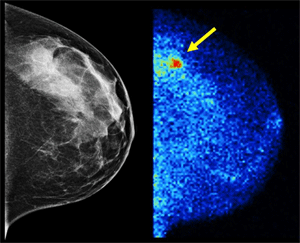Researchers have found a way to “light up” cancer hiding in dense breast tissue.
In the largest-ever study to compare molecular breast imaging (MBI) to mammography, researchers at the Mayo Clinic in Rochester, Minn., have shown that MBI can detect three times as many cancers in women whose mammograms show dense breast patterns and are at increased risk for breast cancer.
Mammograms are the current standard for breast cancer screening. The MBI would not replace mammograms for women at average risk of the disease. However, it might become an additional tool for higher risk women, and it could be done at less cost than an MRI (magnetic resonance imaging).

The image shows a standard mammogram on the left and molecular breast imaging (MBI) from a study performed on a 45-year-old patient in the Clinic's screening of women with dense breasts. The mammogram was interpreted as being negative while the MBI image shows a cancerous growth indicated by the arrow. Photo courtesy of the the Mayo Clinic.
With MBI, patients are injected with a short-living radioactive agent that is absorbed by breast tissue. This agent is tracked with a specialized camera that can distinguish healthy tissue from breast cancer tumors, as cancer cells absorb more of the radioactive agent than healthy cells.
According to the Mayo Clinic, the MBI technology has been in advanced testing for six years.
“These results suggest that MBI could become an important screening tool for women who have dense breast tissue and increased breast cancer risk,” said Carrie B. Hruska, a research fellow in the Department of Radiology at Mayo Clinic in Rochester, Minn. “Larger trials are needed to further validate our research, but it is encouraging to find that MBI can detect cancers that are not easily visible on screening mammography. Our next step will be to compare MBI prospectively to other screening methods, such as MRI.”
Researchers tried both methods on 940 women who met two criteria: dense breasts and a high risk of cancer because of family history, bad genes or other reasons. The study was paid for by The Susan G. Komen for the Cure foundation and Bristol-Myers Squibb, which makes the imaging agent used in the study.
A total of 13 tumors in 12 patients were detected: eight by MBI alone, one by mammography alone, two by both techniques, and two by neither. The recall rates (the number of women who needed follow-up testing) were 7.7 percent for MBI versus 9.4 percent for mammography. Of the 36 biopsies prompted by MBI, 27.8 percent were positive for cancer; of the 17 biopsies prompted by mammography, 17.6 percent were positive for cancer.
The next test will compare the MBI to the MRI. The federal government will pay for the Mayo-lead study that will compare the two in 120 high-risk women with dense breast tissue.
MBI is currently available at a limited number of cancer centers, but its availability is growing.For more information, visit: www.mayoclinic.org